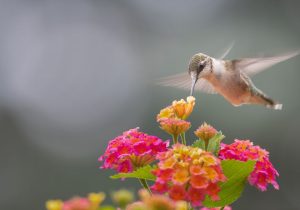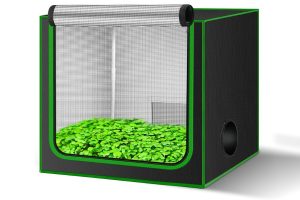Last Updated on May 30, 2024 by teamobn
Gardening is most satisfying when you take the time to look and observe. The gnat on that yarrow plant might actually be a type of native bee pollinating the flowers.
Small, harmless bees can be quite entertaining as they flit about and feed on nectar and pollen.
In the case of bees, what’s pleasing to the eye is pleasing to the earth, as well. Research has shown that the presence of bees increases yields across many types of crops. Experts say bees are more efficient at pollinating native crops than honey bees.
Keeping a bee house also adds to the overall biodiversity of your garden. Bees are part of a complex web of life, and a diverse ecosystem is more resilient to changes and disturbances.
Many bee species are solitary and do not form hives. Providing a bee house offers nesting sites for native bees, which may not have access to suitable nesting places in urban or suburban environments.
Additionally, bees worldwide face threats such as habitat loss, pesticide exposure, and diseases. By providing a bee house, you contribute to the conservation of these important pollinators.
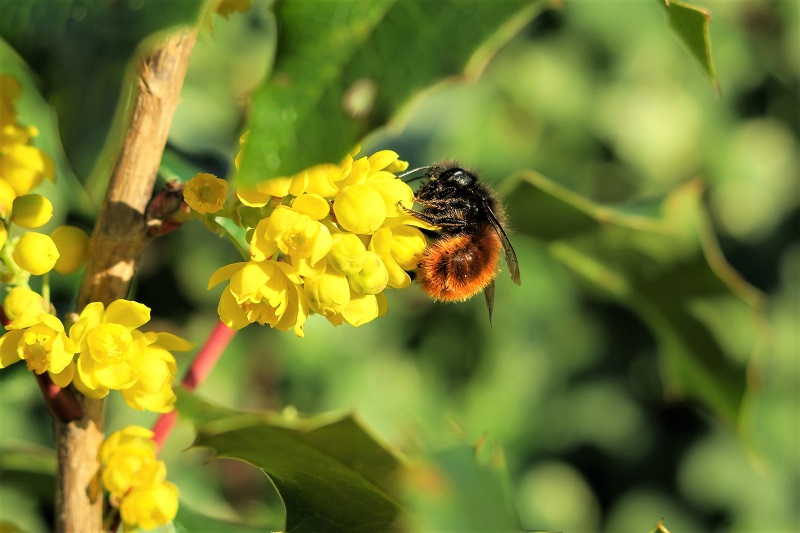
Welcoming Bees Into Your Garden
Of course, other gardeners do more than just observe. They establish nesting tubes for bees. You should, too, if you keep a garden. The artificial shelters can be an effective way to draw certain bee species to your plants.
They are solitary. They don’t live in hives. Instead, they will gather in bundled tubes, one to a tunnel, to shelter and raise their young.
That’s why bee houses are wooden, birdhouse-like structures containing hollow reeds or cardboard tubes. When properly supervised, these little bee shelters are the perfect habitat for lone, hole-nesting native bees.
Below are a few tips on managing a bee house for your garden.
1. Provide proper nesting holes.
Designing and constructing the bee house—with particular attention to the nesting holes—is the first step in making your garden a perfect home for native bees. The health and output of the bees depend on well constructed nesting chambers. This is how to make sure that these important pollinators find a secure and efficient haven in your bee house.
Opt for Removable Nesting Tubes
Selecting a bee house with detachable nesting tubes is critical whether you buy one already made or build one yourself. Easy cleaning and upkeep made possible by this design stop the fungus illnesses that could hurt the bees from growing. Maintaining the health of the bee population living in your garden and preventing disease depend on regular cleaning of these tubes.
Correct Dimensions for Nesting Holes
The size of the nesting holes is pivotal for accommodating different bee species. Ideally, these holes should range from four to 10 millimeters in diameter and be about six inches long. These dimensions cater to a variety of native bees, providing a versatile environment conducive to nesting for diverse species. Proper sizing ensures that the bees can enter and exit the holes comfortably and safely nest within them.
Avoid Inappropriate Materials
While selecting materials for the nesting holes, avoid using bamboo and plastic straws. These materials do not adequately wick moisture, creating damp conditions that can be detrimental to the developing bees. Excessive moisture can lead to mold growth and other issues that negatively impact the health of the bees.
Choose Natural and Local Nesting Materials
The best materials for constructing nesting holes are those that are natural and locally sourced. Many gardeners prefer using wood due to its natural properties that support healthy bee development. Alternatively, cardboard tubes and lake reeds can also be effective, provided they are of the correct size and composition. These materials mimic the bees’ natural nesting environments, making them more attractive to the bees and supporting their lifecycle.
By following these guidelines, gardeners can create a thriving bee house that not only supports the local bee population but also enhances the overall health and biodiversity of the garden. Properly managed bee houses contribute significantly to the success of garden ecosystems, promoting robust plant growth and higher yields through effective pollination.
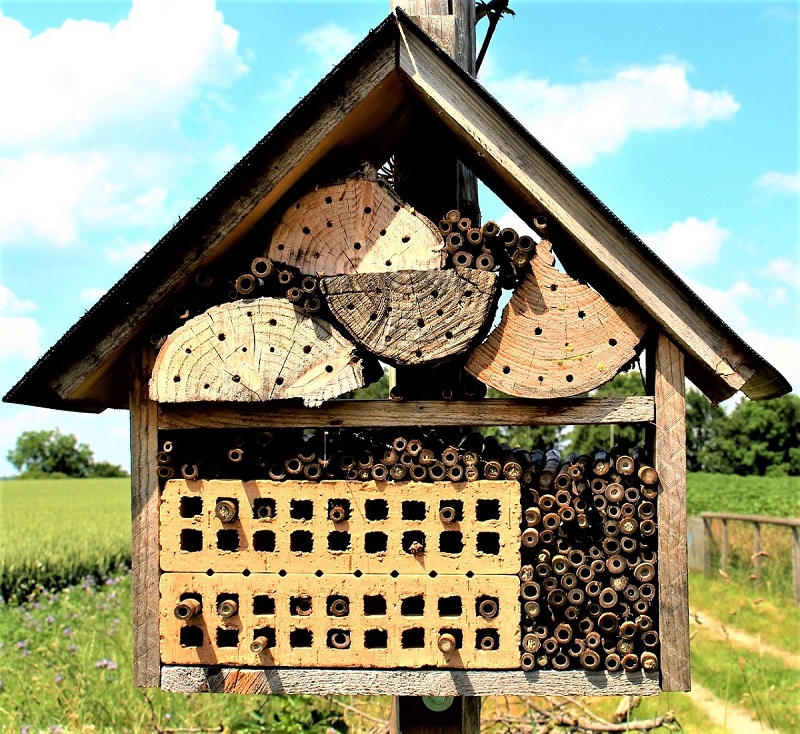
2. Protect the nesting materials from harsh weather and birds.
Protecting the nesting materials within a bee house from harsh weather and predators is crucial for maintaining a healthy and safe environment for bees. Here’s how to ensure your bee house remains a secure haven for these essential garden allies.
Optimize the Structure for Weather Protection
The construction of the bee house should prioritize durability and protection against the elements. A solid outer structure with a two-to-three-inch overhang provides the necessary shelter to keep the nesting materials dry and safe from weather extremes such as rain, wind, and harsh sunlight. This design helps to maintain an optimal internal climate conducive to bee health and egg development.
Use Protective Measures Against Predators
Birds can pose a significant threat to bee populations by preying on bees and their larvae or damaging their nesting sites. To safeguard your bee house from such threats, incorporating a wire mesh around the structure is an effective strategy. This mesh acts as a barrier, preventing birds from accessing the bees while allowing the bees free passage in and out of their nesting holes.
Ensure Adequate Space for Bee Activity
When installing any protective covers or meshes, it’s vital to avoid placing them too close to the bee house apertures. Bees require sufficient space around the entrance of their nesting holes for landing and taking off. This clearance is essential for their ability to navigate and access their nests with ease. Proper spacing promotes healthy bee activity and reduces stress on the bee colony, enhancing their productivity and longevity in your garden.
By focusing on these protective measures, you can create a more sustainable and effective bee house. This not only supports the local bee population but also contributes to a flourishing garden ecosystem through improved pollination and plant health.
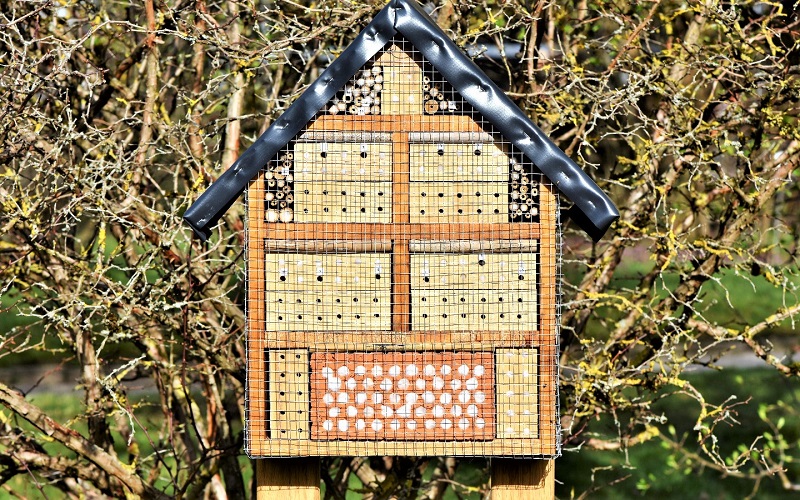
In case nesting holes are frequently targeted by birds, consider securing the bee house by encircling it with a wire mesh.
3. Make sure your bee house is not too large.
Ensuring that your bee house is appropriately sized is critical for maintaining the health and efficiency of your bee habitat. A bee house that is too large can lead to unforeseen challenges and potential risks for the bee population. Here’s a closer look at why size matters and how to manage it effectively.
Manageable Size for Effective Maintenance
Insect hotels often feature a variety of sections designed to accommodate different species, including bee tubes for solitary bees. While these structures are beneficial for biodiversity, their large size and complexity can make routine maintenance difficult.
Bee tubes, in particular, require regular cleaning and monitoring to prevent disease and ensure the health of the bees. By keeping the bee house relatively small and focused, you can manage these tasks more effectively, ensuring that each tube is properly maintained and replaced as necessary.
Consider Your Commitment to Upkeep
Usually once a year, a bee house needs to have its nesting materials replaced and be checked over. Think on how much time and work you are ready to put into maintaining your bee house before choosing its size. For many gardeners—especially those with little time for gardening duties—a smaller bee house is a more practical choice because it takes less time to clean and replenish.
Avoid Overcrowding to Prevent Health Issues
One typical problem in bigger buildings is overpopulation, which is avoided by a smaller bee house. Bees that are crowded may compete more fiercely for resources and run the danger of contracting diseases and parasites.
Because smaller bee houses provide a better balance in the bee population and lower the risk of these problems, experts frequently advise them. Reducing the size of the bee house gives each bee a safer, more regulated habitat that promotes their health.
Your bee house will be a sustainable addition to your landscape if you pay attention to these factors. Healthy bee populations are promoted by appropriately sized bee houses, which improves pollination and general garden vitality.
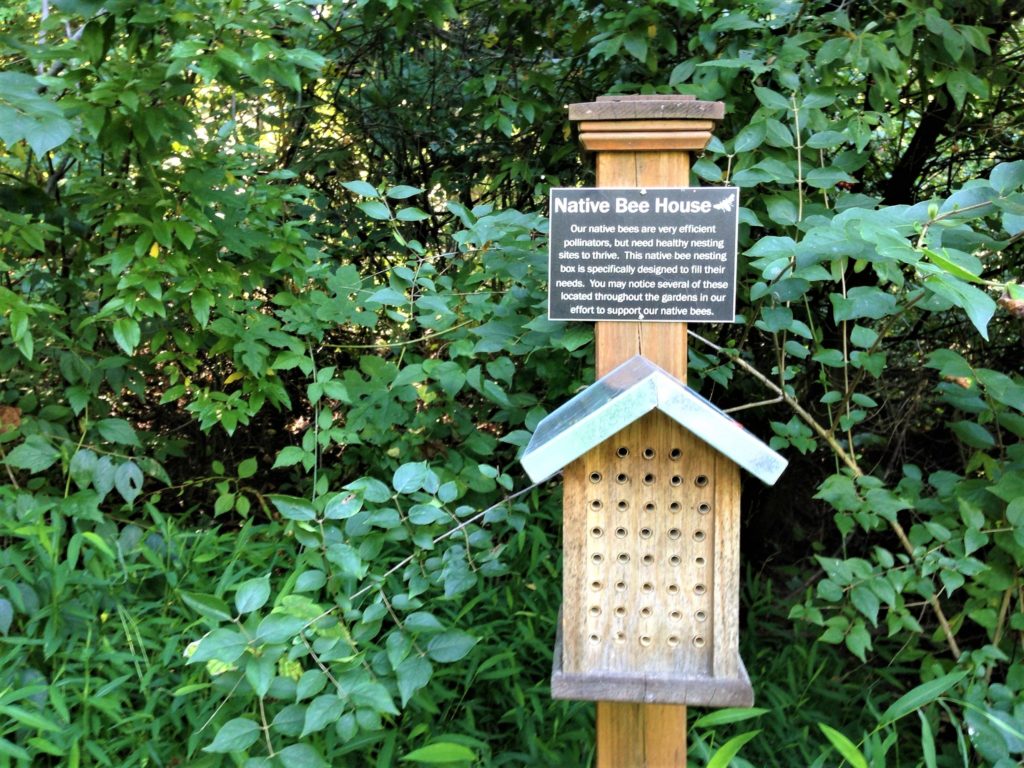
4. Ensure proper location and orientation.
Choosing the right location and orientation for your bee house is crucial to the success of your garden’s pollination efforts and the health of the bees. Here’s how to optimally position your bee house to ensure it provides a beneficial environment for bees while avoiding potential hazards.
Orient the Bee House Towards the Morning Sun
Positioning the bee house so that it faces the morning sun is vital for the bees’ daily activities. Hole-nesting bees rely on the sun’s warmth to energize themselves for the day’s work of pollination and foraging.
The morning sunlight helps to warm up the bees quickly after the cooler night, kickstarting their metabolism and activity levels. This early exposure to sunlight is essential for maximizing their productivity throughout the day.
Provide Afternoon Shade to Avoid Overheating
While bees need sunlight, too much direct exposure, especially in the hotter parts of the day, can lead to overheating and dehydration. To prevent this, ensure that your bee house receives some shade during the afternoon.
This can be achieved by positioning it near structures or plants that cast a shadow as the sun moves. However, be cautious not to place the bee house in an area that is overly shaded, as this can lead to dampness and attract unwanted pests.
Balance Sunlight and Shade to Deter Predators
The right amount of sunlight mixed with shade not only ensures optimal temperature and comfort for bees but also helps in deterring predators such as wasps. Solitary wasps, which can be both beneficial and detrimental, are attracted to excessively shaded and cool areas.
These wasps prey on common garden pests but may also pose a threat to bee populations by preying on bee pupae. By strategically placing your bee house to receive balanced sunlight and shade, you can reduce the likelihood of wasp interference while providing a safe nesting environment for your bees.
The location and orientation of the bee house are as important as the structure itself. By ensuring it receives morning sunlight and balanced afternoon shade, you create an environment that supports bee health and productivity, enhances your garden’s pollination, and maintains the natural balance by keeping potential predators at bay.

5. Protect bee larvae during winter.
Protecting bee larvae during the winter months is crucial for ensuring the survival and health of the next generation of pollinators. Here are some effective strategies for safeguarding these vulnerable stages of bee life when temperatures drop.
Provide Easy Access for Maintenance
Ensuring that the nesting materials are easily accessible is essential for winter preparation. This allows for regular checks and the removal of nesting materials that need to be relocated to a controlled environment during the colder months. Easy access facilitates the careful handling of these materials, minimizing disturbance to the developing larvae.
Store Nesting Materials in a Controlled Environment
Once the nesting materials are filled and the bees have completed their life cycles within them, they should be moved to a location that mimics the cool, but not freezing, conditions they would naturally experience outside.
This can be a shed, an unheated garage, or any similar structure that provides protection from extreme cold and wet conditions. The goal is to keep these materials dry and just above freezing to ensure the larvae remain dormant until spring.
Protect from Pests and Predators
During storage, it’s important to protect the larvae from natural predators, such as parasitic wasps, which can infiltrate the nesting materials and harm the developing bees. Encasing the nesting materials in a fine mesh bag can provide an effective barrier against these pests. The mesh allows air to circulate, preventing mold and mildew, while keeping out insects that could pose a threat to the larvae.
By taking these steps to maintain and protect bee larvae during winter, you help ensure the emergence of a healthy new generation of bees when spring arrives. This care not only contributes to the vitality of your local ecosystem by supporting bee populations but also enhances your garden’s productivity through effective pollination.
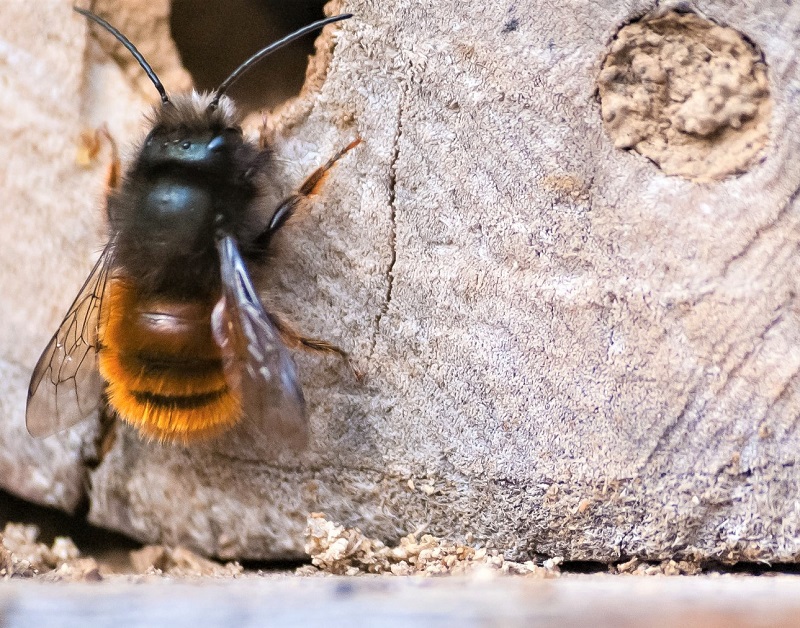
A Mutually Beneficial Relationship
Keeping up a bee-friendly garden creates a symbiotic relationship between the gardener and these vital pollinators, with advantages to both of them that go beyond the garden. The development of this association and its beneficial effects are examined in more detail here.
Harvesting and Managing Cocoons
Opening and examining the nesting materials used by bees is best done in the early spring, according to recommendations from reliable sources like The Old Farmers’ Almanac. Organizing and examining the cocoons according to their appearance during this time will help gardeners determine their health and readiness for the upcoming season. This method promotes the growth of a new generation of bees by maintaining the cocoons in ideal conditions.
Benefits of a Pollinator-Friendly Garden
The pollination process, which bees greatly facilitate, greatly increases a garden’s ability to produce fruits, vegetables, seeds, and berries. Gardeners who give bees a habitat benefit from increased yields and more abundant harvests. In this partnership, which shows off the ideal of nature’s give-and-take, the gardener offers refuge and gains from the bees’ pollinating efforts.
Educational and Enjoyment Aspects
Apart from the useful advantages, watching bees has intrinsic enjoyment and educational value. It can be calming and instructive to watch these hardworking animals go about their daily business. Seeing bees can help one better grasp the intricacies of the natural world and the value of conservation efforts. It emphasizes the interdependence of our ecosystem and the vital part pollinators play in preserving the condition of our surroundings.
Broader Environmental Impact
Supporting bee populations that are now under danger is another way that keeping a bee-friendly garden improves the health of the environment as a whole. Gardeners contribute to biodiversity conservation and species survival that is essential to our ecological balance by providing safe havens for bees.
Finally, there are numerous advantages and a very reciprocal interaction between gardeners and bees. It improves garden health and productivity and also encourages a deeper respect for the natural world and supports environmental conservation initiatives, demonstrating how little deeds done in one’s backyard may have a big worldwide influence.
The Wrap Up
Embark on a journey into the heart of your garden. This guide is your passport to creating a vibrant sanctuary for our pollinator pals. From offering a diverse menu of nesting materials to strategic bee-house placement that catches the sun’s warm embrace, each tip is a brushstroke in the masterpiece of a joyful hive.
With routine check-ups and a garden adorned with native plants, this guide unveils the secrets to a thriving, buzzing utopia. Step into the enchanting world where gardens hum with happiness, and bees dance to the rhythm of nature. Are you ready to begin your journey?




